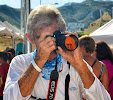Pedro and Julio Meza, on the left organize a series of
tournaments throughout the Baja Peninsula, Baja Norte and Baja Sur.
Pedro Sors, a dedicated sportfisherman, is the host and producer of one
of the most popular Mexican television sportfishing shows called Con Caña y
Carrete. He and Julio Meza, a San
Quintin produce grower and owner of FISHCO.com organize a series of tournaments
throughout the Baja Peninsula, Baja Norte and Baja Sur. These tournaments include the Governor's Cup
series which feature a three-venue contest that was held this year in San
Felipe, San Quintin and Ensenada.
Recently, I had the opportunity to meet Pedro and Meza at a Governor's
Cup in San Quintin. Aboard Julio's center
console Contender name "Blessed" speeding out the inner bay with
Julio at the helm, they explained the details of the Governor's Cup series.
The one day tournaments, which are open to anyone, offer prizes of cash
and equipment for the largest fish in both surface and bottom categories for
men, women and children divisions. In addition, anglers accumulate points at
each of the three events that are totaled to determine the combined overall
champions for the series. Each event is featured on the Con Caña y Carrete television
program.
The series was first conceived during the term of Baja Sur’s El Gobernador Narciso Agúndez Montaño in 2006.
It was designed to introduce sportfishing to the locals, involving not only the
adults in the many small communities that dot the coastline of the state, but
the children as well. When El Gobernador
Agúndez left office the incoming Gobernador decided to abandon the series for
economic reasons.
At that point, recognizing that every tournament is an opportunity for sportfishing
education in small communities, Meza and Sors decided to work together to
resume the important series. Punta Eugenia, Abreojos and La Bocana were added
to the list along with the tournaments planned for the future.
Pedro Sors' interest in sportfishing is deep and goes way beyond just
catching fish, which he seems to be doing somewhere in Mexico every week. In
2003 he discovered that sportfishing was not officially recognized by the
Mexican government. It didn't exist legally at that time. The National Council
of Fisheries only recognized groups officially designated by the government.
He began speaking to fishing friends encouraging them to unify and form
a Federation of Sportfishing. Taking advantage of the people he had met though
his television program, several years later in 2005 through his efforts and
those of other friends and acquaintances, the Federación Nacional
de Pesca Deportiva A.C was formed representing
sportfishing clubs in seven Mexican states initially.
Since then, the group has grown to represent sportfishing
clubs in twenty-seven states with a combined membership of 32,000.
According to Sors, founder and past president, some of their
accomplishments include:
Acquiring
two seats on the National Board of Tourism that meets twice a year.
They encouraged
states to facilitate the sale of fishing licenses, allowing the license fees to
be used in individual states.
Convinced
the Secretary of the need for more boat launching ramps resulting in an ongoing
program that resulted in 80 new or improved ramps between 2009 and 2011.
Persuaded
the Federal Secretary of the Treasury, a golfer, to eliminate Boat Permits by
arguing that golfers were not required to pay green fees for their golf carts
so why should the government charge a sportfisherman a fee for the boat he
fishes from.
The Federation
has fielded and won in several International World Sportfishing Championships, as well as hosting Big Game and Bass
championships in Mexico.
The
Federation addressed a law forbidding
filleting fish aboard a boat and convinced the Secretary to amend the
wording to read that it is unlawful to unload
filleted fish.
It was
against the law to fish with live bait. The Secretary was uninformed about
sportfishing. When the Federation explained how many families supported
themselves by selling live bait he realized the law needed to be changed.
These are the kinds
of issues the Federation seeks to change. Though it has had some setbacks and
failures along the way, it has had many successes.
Julio Meza and Pedro Sors, both avid and passionate Mexican sportfishermen,
seem to be taking up where the group I wrote about in May 2009 http://roadtrekker.blogspot.com/2009/05/grass-roots-tournaments.html
left off, continuing to introduce and promote sportfishing throughout Baja. Their efforts on behalf of sportfishing should
be applauded by anglers everywhere!






















